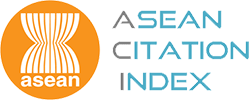Influence of Machining Parameters on Surface Roughness and Tool Flank Wear in Milling of Semi-Solid A356-T6 Aluminum Alloy
Keywords:
กระบวนการกัดด้วยดอกเอ็นมิล, อลูมิเนียมหล่อแบบกึ่งของแข็ง A356, การออกแบบการทดลองแบบเศษส่วนแฟคทอเรียล, ค่าความหยาบผิว, การสึกหลอที่มุมหลบของดอกเอ็นมิลAbstract
บทคัดย่อ จุดประสงค์ของงานวิจัยนี้ คือ การศึกษาผลกระทบของปัจจัยในการตัดเฉือนและรูปทรงของดอก เอ็นมิล ประกอบด้วย 7 ปัจจัย คือ อัตราป้อนต่อฟัน ความเร็วตัด ความลึกการกัดในแนวรัศมี ความลึกการกัดในแนวแกน มุมคายเศษ มุมเลื้อย รวมถึงจำนวนคมตัดที่ส่งผลต่อค่าความหยาบของผิวและการสึกหรอที่มุมหลบของดอกเอ็นมิลในกระบวนการกัดอะลูมิเนียมหล่อแบบกึ่งของแข็งเกรด A356-T6 ที่ขึ้นรูปด้วยกรรมวิธีการปล่อยฟองแก๊สเข้าไปในน้ำโลหะขณะมีการแข็งตัว (GISS)และผ่านกระบวนการทาง ความร้อน T6 ในงานวิจัยนี้ชิ้นทดสอบถูกกัดแบบแห้งด้วยเครื่องซีเอ็นซีมิลลิ่ง และดอกเอ็นมิลคาร์ไบด์ขนาด 12 มิลลิเมตร จากนั้นค่าความหยาบผิววัดโดยเครื่องวัดความหยาบผิว และการสึกหรอของดอกเอ็นมิลวัดด้วยกล้องไมโครสโคป งานวิจัยนี้ใช้การออกแบบการทดลองแบบเศษส่วนแฟคทอเรียล 2 ระดับในการออกแบบการทดลองและใช้วิเคราะห์ผลทางสถิติ จากการทดลองพบว่าผลกระทบของปัจจัยหลักที่ส่งผลต่อค่าความหยาบผิวมากที่สุดคืออัตราป้อนต่อฟัน ตามด้วยจำนวนฟัน มุมคายเศษ ความลึกการตัดในแนวรัศมีและจำนวนคมตัดตามลำดับ ส่วนปัจจัยหลักที่ส่งผลต่อการสึกหรอที่มุมหลบของดอกเอ็นมิล คือ จำนวนคมตัด อัตราป้อนต่อฟัน ความลึกการตัดในแนวรัศมี และความลึกการตัดในแนวแกนคำสำคัญ: กระบวนการกัดด้วยดอกเอ็นมิล อะลูมิเนียมหล่อแบบกึ่งของแข็ง A356 การออกแบบการทดลอง แบบเศษส่วนแฟคทอเรียล ค่าความหยาบผิว และการสึกหรอที่มุมหลบของดอกเอ็นมิล ABSTRACT The purpose of this study was to determine the influence of machining parameters and tool geometry which are consisted of seven parameters; feed per tooth, cutting speed, radial depth of cut, axial depth of cut, rake angle, helix angle and number of teeth on surface roughness and tool flank wear in CNC end milling process of aluminum semi-solid A356. The workpieces were sized 48x48 millimeters cross section and 100 millimeters in length. These workpieces were produced by Gas Induced Semi-Solid Squeezed Casting (GISS-SC) and T6 heat treatment process. The settings of machining parameters in this experiment were conducted through the one eight fraction factorial experimental design. In addition, CNC machining center and uncoated carbide end milling cutter with a diameter of 12 millimeter were used under dry cutting condition. The surface roughness of face end-milled was measured by the surface roughness tester and the tool flank wear was measured by microscopes. It was found that the strongest main factor influence to surface roughness was feed per tooth, followed by number of teeth, rake angle, radial rake angle and cutting speed respectively. On the tool flank wear, number of teeth, feed per tooth, radial depth of cut and axial depth of cut were found to have significant influence.Keywords: end milling process, aluminum semi-solid A356, fractional factorial design, surface roughness, tool flank wearDownloads
Download data is not yet available.
Downloads
Published
2019-06-25
How to Cite
Thanasuptawee, U., Prapaspong, A., Ingkawara, S., & Siwadamrongpong, S. (2019). Influence of Machining Parameters on Surface Roughness and Tool Flank Wear in Milling of Semi-Solid A356-T6 Aluminum Alloy. Science Essence Journal, 35(1), 19–34. Retrieved from https://ejournals.swu.ac.th/index.php/sej/article/view/10018
Issue
Section
Research Article








